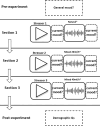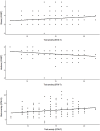Natural soundscapes enhance mood recovery amid anthropogenic noise pollution
- PMID: 39602385
- PMCID: PMC11602051
- DOI: 10.1371/journal.pone.0311487
Natural soundscapes enhance mood recovery amid anthropogenic noise pollution
Abstract
In urbanised landscapes, the scarcity of green spaces and increased exposure to anthropogenic noise have adverse effects on health and wellbeing. While reduced speed limits have historically been implemented to address traffic safety, their potential impact on residents' wellbeing, especially in relation to engagement with natural soundscapes, remains understudied. Our study investigates the influence of i) natural soundscapes, including bird song, and ii) the addition of traffic noise to natural soundscapes at two speeds (20 mi/h and 40 mi/h) on mood. We found that natural soundscapes were strongly linked with the lowest levels of anxiety and stress, with an increase in stress levels associated with mixed natural soundscapes with the addition of 20 mi/h traffic noise and the highest levels with 40 mi/h traffic noise. Higher levels of hedonic tone, indicative of positive mood, was noted with natural soundscapes, but diminished when combined with 40 mi/h traffic noise. Our results show that anthropogenic soundscapes including traffic sounds can mask the positive impact of natural soundscapes including birdsong on stress and anxiety. However, reducing traffic speeds in cities could be a positive intervention for enhancing access to nature. Technological solutions, such as the widespread adoption of hybrid and electric vehicles, and urban planning strategies like integrating green spaces into transit routes, offer potential opportunities to mitigate the impact of noise pollution and benefit humans in urban environments.
Copyright: © 2024 Gilmour et al. This is an open access article distributed under the terms of the Creative Commons Attribution License, which permits unrestricted use, distribution, and reproduction in any medium, provided the original author and source are credited.
Conflict of interest statement
The authors have declared that no competing interests exist.
Figures



References
-
- Francis C.D., Newman P., Taff B.D., White C., Monz C.A., Levenhagen M., Petrelli A.R., Abbott L.C., Newton J., Burson S. and Cooper C.B. (2017) Acoustic environments matter: Synergistic benefits to humans and ecological communities. Journal of environmental management, 203, 245–254. doi: 10.1016/j.jenvman.2017.07.041 - DOI - PubMed
-
- Kaplan S., 1995. The restorative benefits of nature: Toward an integrative framework. Journal of environmental psychology, 15(3), pp.169–182.
-
- Nghiem T.P.L., Wong K.L., Jeevanandam L., Chang C., Tan L.Y.C., Goh Y. and Carrasco L.R., 2021. Biodiverse urban forests, happy people: Experimental evidence linking perceived biodiversity, restoration, and emotional wellbeing. Urban Forestry & Urban Greening, 59, p.127030.
MeSH terms
LinkOut - more resources
Full Text Sources
Medical

